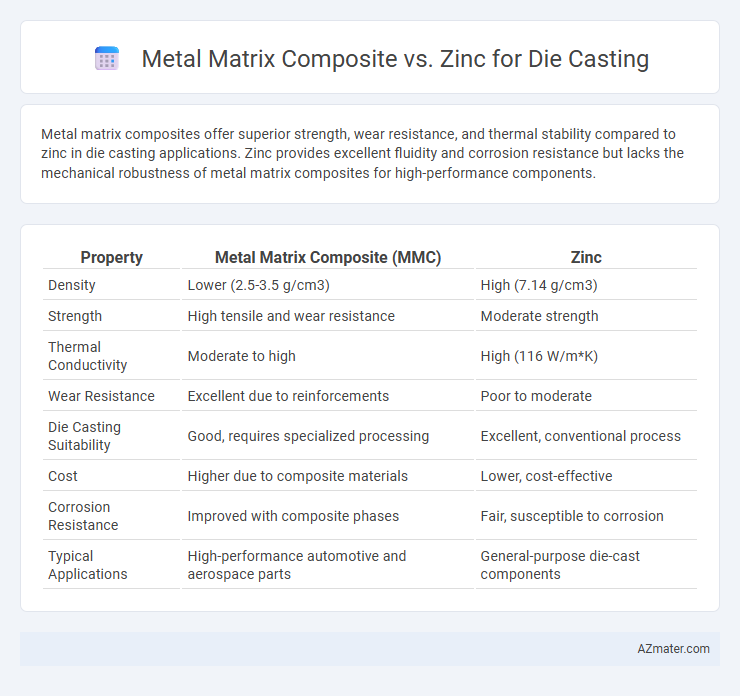Metal matrix composites offer superior strength, wear resistance, and thermal stability compared to zinc in die casting applications. Zinc provides excellent fluidity and corrosion resistance but lacks the mechanical robustness of metal matrix composites for high-performance components.
Table of Comparison
| Property | Metal Matrix Composite (MMC) | Zinc |
|---|---|---|
| Density | Lower (2.5-3.5 g/cm3) | High (7.14 g/cm3) |
| Strength | High tensile and wear resistance | Moderate strength |
| Thermal Conductivity | Moderate to high | High (116 W/m*K) |
| Wear Resistance | Excellent due to reinforcements | Poor to moderate |
| Die Casting Suitability | Good, requires specialized processing | Excellent, conventional process |
| Cost | Higher due to composite materials | Lower, cost-effective |
| Corrosion Resistance | Improved with composite phases | Fair, susceptible to corrosion |
| Typical Applications | High-performance automotive and aerospace parts | General-purpose die-cast components |
Introduction to Die Casting Materials
Metal matrix composites offer enhanced strength-to-weight ratios and superior thermal conductivity compared to traditional zinc alloys used in die casting, making them ideal for high-performance applications. Zinc alloys provide excellent fluidity, corrosion resistance, and dimensional stability, which are beneficial for producing intricate and precise die-cast components. Selecting between metal matrix composites and zinc depends on the specific mechanical properties, thermal requirements, and cost-effectiveness needed for the intended application.
Overview of Metal Matrix Composites (MMC)
Metal Matrix Composites (MMCs) combine metal alloys with reinforcing materials like ceramics or fibers to enhance mechanical properties such as strength, stiffness, and thermal resistance compared to traditional die-casting materials like zinc. MMCs offer superior wear resistance, higher temperature tolerance, and improved strength-to-weight ratios, making them ideal for high-performance automotive and aerospace applications. Unlike zinc, which provides excellent castability and corrosion resistance, MMCs excel in environments demanding exceptional durability and structural integrity.
Properties of Zinc Alloys in Die Casting
Zinc alloys in die casting exhibit excellent fluidity, enabling the formation of intricate, thin-walled components with high dimensional accuracy and smooth surface finishes. Their superior mechanical properties include good strength, hardness, and corrosion resistance, making them ideal for automotive, electrical, and consumer applications. Compared to metal matrix composites, zinc alloys offer lower melting points and cost-effective production, but with limited wear resistance and thermal conductivity.
Mechanical Strength: MMC vs Zinc
Metal matrix composites (MMCs) exhibit significantly higher mechanical strength compared to zinc alloys used in die casting, offering improved tensile strength and wear resistance. MMCs combine metal with reinforcing materials such as ceramics, which enhance stiffness and load-bearing capacity beyond that of conventional zinc die-cast parts. Zinc alloys, while advantageous for precision and corrosion resistance, typically have lower tensile strength and fatigue resistance than MMCs, limiting their use in high-stress applications.
Corrosion Resistance Comparison
Metal matrix composites (MMCs) exhibit superior corrosion resistance compared to zinc alloys in die casting due to their reinforced ceramic or metallic particles that inhibit oxidative degradation and enhance longevity. Zinc die cast components are more susceptible to galvanic corrosion, especially in humid or saline environments, which limits their application in corrosive conditions. The enhanced durability of MMCs in aggressive environments makes them a preferred choice for high-performance applications requiring long-term corrosion resistance.
Thermal Conductivity and Performance
Metal matrix composites (MMCs) exhibit superior thermal conductivity compared to zinc alloys commonly used in die casting, enabling more efficient heat dissipation and improved thermal management in high-performance applications. MMCs typically combine metals like aluminum or copper with ceramic reinforcements, which enhance their thermal stability and mechanical strength over the relatively lower thermal conductivity and mechanical properties of zinc die cast parts. The enhanced thermal conductivity and performance of MMCs result in reduced cycle times and increased durability in die casting molds and components, making them ideal for automotive and aerospace industries.
Die Casting Process Compatibility
Metal matrix composites (MMCs) exhibit superior heat resistance and mechanical strength compared to zinc, making them suitable for high-performance die casting applications requiring enhanced durability and wear resistance. Zinc alloys offer excellent fluidity and low melting points, facilitating faster cycle times and improved mold filling during the die casting process. Compatibility with die casting equipment favors zinc due to its lower processing temperature, while MMCs often require advanced die materials and precise thermal management to prevent premature tool wear.
Cost-Effectiveness and Scalability
Metal matrix composites (MMCs) generally offer higher performance in die casting but come with increased material and processing costs compared to zinc alloys, which are more cost-effective due to their lower raw material price and established manufacturing methods. Zinc's excellent fluidity and shorter cycle times enable greater scalability for high-volume production runs, whereas MMCs often require specialized equipment and longer processing times, limiting large-scale adoption. Choosing zinc for die casting maximizes cost-efficiency and scalability in mass production, while MMCs suit applications demanding enhanced mechanical properties despite higher expenses.
Typical Applications for MMC and Zinc Die Castings
Metal matrix composites (MMCs) are typically used in aerospace, automotive, and defense industries for components requiring high strength-to-weight ratios, wear resistance, and thermal stability, such as engine parts, brake rotors, and armor. Zinc die castings are commonly found in consumer electronics, automotive hardware, and household appliances due to their excellent corrosion resistance, dimensional accuracy, and cost-effectiveness for intricate shapes like housings, gears, and connectors. MMCs provide superior mechanical properties for high-performance applications, while zinc alloys excel in versatility and ease of manufacturing for mass production.
Future Trends and Material Innovations
Metal matrix composites (MMCs) are increasingly favored over traditional zinc alloys in die casting due to superior strength-to-weight ratios and enhanced thermal conductivity, driving innovation in aerospace and automotive sectors. Future trends emphasize the integration of nano-reinforcements and hybrid composites to improve wear resistance, corrosion protection, and fatigue life, outperforming conventional zinc die-cast parts. Advances in additive manufacturing and powder metallurgy enable tailored MMC microstructures, promising greater design flexibility and sustainability in high-performance die casting applications.

Infographic: Metal matrix composite vs Zinc for Die casting
 azmater.com
azmater.com